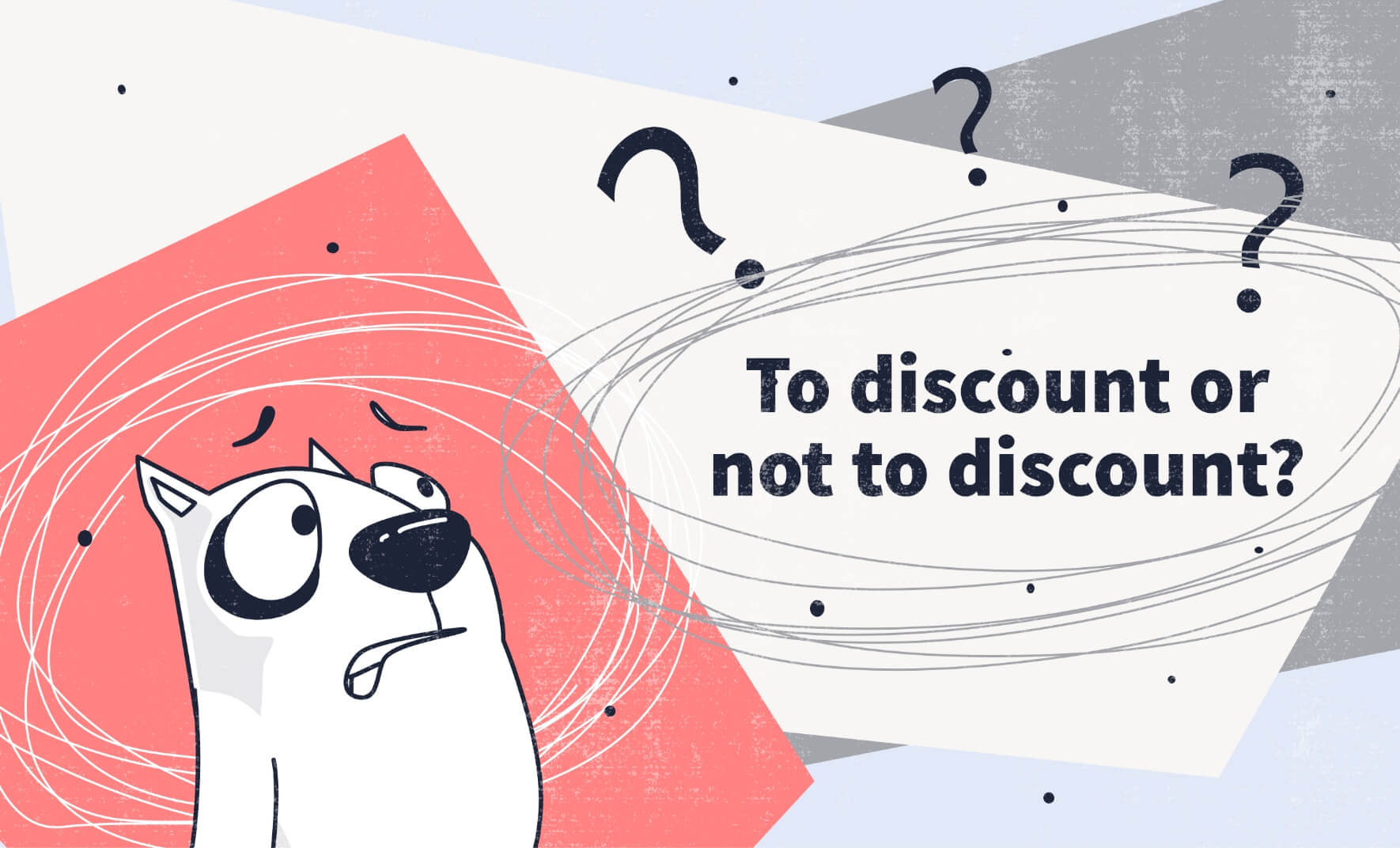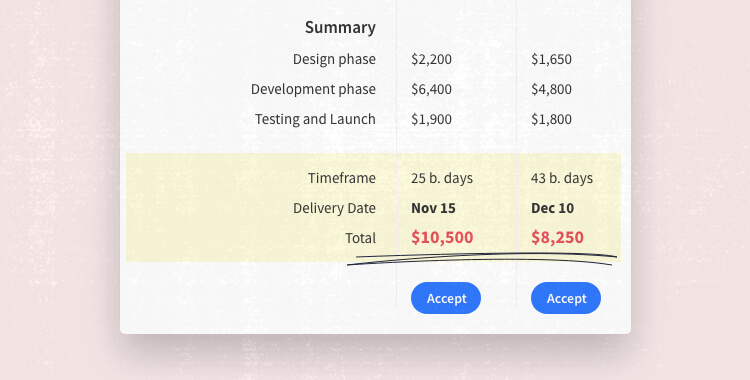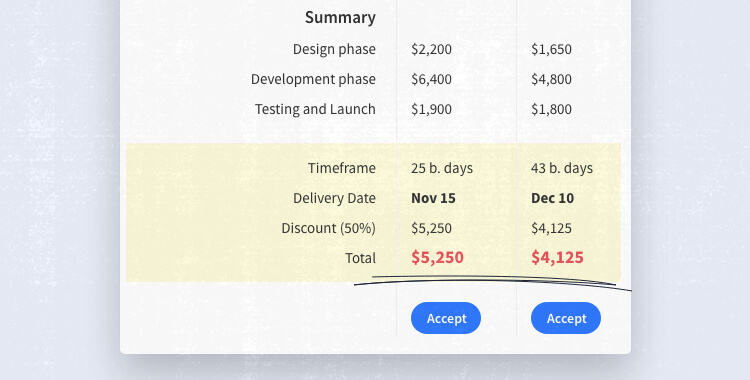To discount or not to discount? That’s not even a question

Pricing is a tricky area, especially in service industries. It’s difficult to put a figure on experience, knowledge, expertise, but that is what you have to do. You have the ability, you’ve often taken years of training and study to get to this place and now you have to persuade the clients that you have what it takes at a price that’s right for them.
You have your price in mind, you’ve worked out a system of pricing but the temptation is to introduce one of the most widespread and obvious pricing strategies in order to get some work in. We are talking about discounting and tempting as it may be the risk definitely outweigh the rewards in your field at least.
What is a discount pricing strategy?
Discount pricing is the type of pricing strategy where you mark down the prices of your goods or services. The main goal of a discount pricing strategy is to stimulate customers, increase customer traffic, and increase the volume of sales. In the retail world, it’s also great for clearing out old stock, creating shelf space. It’s not a new concept but it doesn’t have to be, it works to a certain extent.
Basically this means that instead of getting this for your work:

you will get this:

Does discount pricing really work for service businesses?
Whilst discount pricing is clearly a big favorite on the high street, and with retailers, in general, there are question marks hanging over its usefulness. Everybody is trained to love a bargain but if people are too prepared to wait for the discounts, the real value of the product becomes the discounted price.
Extremely large powerful retailers can use their huge purchase power to get deals from suppliers and create discounts without losing profit and certainly in certain areas and in the short term it can be a solution to clear the decks or generate income but long term you are devaluing your product.
However, for service businesses such as web design or development agencies you need to do the math. If your general profit per project is in the region of 30% and you give a 20% discount that leaves you with an overall profit of 10%. You aren’t going to last long in this business.
In short, discount pricing is not the right pricing strategy for you.
Why discounting is bad for your company and should be avoided at all costs
Not convinced? So, here’s why discounts are bad for service businesses and do more harm than good.
Whilst it may get your business short term, in the long run, you are damaging your whole company brand. Whilst the clients might come flooding in, you get lots of work, but not much else out of it. Now comes the time to raise the prices and suddenly it’s shock treatment for all concerned. And that’s not to mention the secondary issues that will emerge.
You are positioning your company as a cheap one
You are conditioning your customer to your discounted price. You are devaluing your product, you are devaluing your whole company.
Let’s say you want a really flash, expensive car, a Ferrari. Ask yourself what you are getting? A decent mid-range vehicle can get you from A to B in much the same way. Ferrari has built an image around being an expensive luxury, you don’t need a Ferrari but you want one. Why? Partly because you know it’s price represents top-quality, and you trust the brand – it wouldn’t work if Ferrari’s were breaking down left, right and center. But you also want one because you know other people can’t afford it, you don’t want many people to have them because the value to you, the image it represents has been diluted. When have you ever seen a Ferrari with 50% off?
An extreme example, but nevertheless it’s worth bearing in mind.
Cheaper = Lower Quality
Your prices are cheap, therefore you are seen as cheap. There are no two ways about it, you haven’t got the reputation to ride this out. If cheap is what you are, cheap is what you will be seen to be. And a cheap reputation is a difficult one to lose. Nobody wants to shop in the bargain basement all the time, or at least the ones that do aren’t really the clients you want. They are happy to take a yogurt at 50 % off because it’s going out of date, they understand this is a one-off lucky break and they understand why it’s discounted. The same understanding doesn’t work with your projects. Cheap by name, cheap by nature. They’ll bail out as soon as your prices rise because they don’t understand the reason why it should.
Cheaper can be suspicious
You get nothing for nothing. If the deal is too good to be true, it usually is too good to be true. How can you charge so little if you are a genuine company? At the very least the clients realize you aren’t going to be a long term option. The internet still raises suspicions, especially in the older generation. Are you some teenager in a bedroom, trying to earn a quick buck? Are you going to take what you can and run? Questions, questions?? How can you possibly be so cheap and do the job properly?
Even in retail the vast majority of shoppers will avoid the cheapest products, and hit the mid-range. Trust is vital in the service industries. If I get 10 quotes for my new swimming pool, 9 are in the same ballpark and one is 50% cheaper, I’m afraid the cheapest is dismissed immediately – at isn’t going to last, what materials will be used? Will they even complete it?
Focus on value, not price
All good businesses produce a product that gives value to the customer. If your clients are so focused on your discounted price, they aren’t so focused on the value your product is giving them. You need to position yourself in a way that says, “you’re paying for a quality service which will generate you increased revenue.” Our service will increase your company’s value. Look up, not down. It’s a steady climb to the top not a race to the bottom.
Clients get used to discounts
The client quickly begins to see this price not as a discounted special but as the expected price, it’s standard and normal for them. Then you want to put the prices up, and the arguments really start. Same product, same price – makes sense. Where are you getting the extra from? The service is the same, your knowledge is the same, your coding takes the same time if you’ve got a more expensive coffee machine – that’s your problem, not mine.
If you have to justify you are on the back foot.
Clients will get angry when they find out you don’t treat them equally
If you are discounting to some clients and not others, it’s a risky strategy. It is a global world, but still a very small world in many cases. Word spreads, if someone’s getting special treatment…..then someone else isn’t. And the clients you’ll lose are exactly the ones you want to keep, the ones with a sense of fairness, honor, integrity.
Compete only on price, and win a battle but lose the war
When price becomes your only weapon, then you are poorly armed. You should be looking to push quality, professionalism, knowledge, and expertise. Your years of training and study, your professional development, learning new skills to keep up with the trends, and new software – these things can’t be cleared off the shelves to make way for this summer’s latest colors or fads. The fight to the bottom is a dirty fight and one that you will not relish.
Team motivation hits rock bottom
If people see you as a cheap company, you will see yourselves as a cheap company. Not only will your staff feel devalued, but motivation will be a real problem. Few talented people want to work at the bottom end of the market, they understand the issues and problems that will come with a penny-pinching mentality. Your best developers will look to move on, new ones won’t stick around, and high staff turnover isn’t going to help you establish consistency of performance or company growth.
Cutting corners to get your profit back
You’re cheap but you still have to make money, the only way is to start cutting corners. Quality will worsen, timeframes become tighter, less time and care is taken to check, staff wages, personnel, the little things that made it a nice place to work……they’ve all gone. Before you know it, there is no toilet paper provided, and the staff knows it’s time to move on. The circle is ever decreasing.
Finally, your profit will be Squeezed
The ever-decreasing circle is tightening into a noose. Staff is leaving, profits are squeezed, complaints are coming in, there’s more pressure to do more with less….it’s not worth it anymore.
What you can do instead
It’s not all doom and gloom, just because discount pricing is off the table doesn’t mean there aren’t any pricing strategies and systems that will totally work for your kind of business. Don’t give up, you still need to be active and inventive in trying to attract and retain clients.
There are plenty of alternative ideas that could tick the boxes for your business. Competitive pricing, bundle pricing, psychological pricing, and price maximization are just some recommended options when figuring out how to create and value and profit for your hard work and still be attractive to the client. We’ll look into some of these ideas in another article.
Closing words
The idea of sitting back with your pricing structures and waiting for the clients to come knocking at your door is a lovely fantasy. Some will follow your marketing and be drawn to you and hopefully, you can build from this.
But it is an increasingly competitive market with rivals ready to undercut you and clients will be looking for the best deals. You need to be flexible, move with the situations, show innovation but you also need to find that beautiful sweet spot that hits the profitable, worthwhile price that pleases the client. Discounting is not the answer, you are not a supermarket.